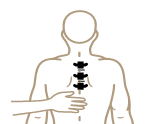ML is a bright, intelligent 35-year-old mother of two children and has a busy, stressful job working in marketing. She was on maternity leave when she first came to see me. She was in a great deal of pain having been involved in four car accidents from 1995-1998 and suffered whiplash on all of her accidents. She has experienced neck pain and muscle tension in her neck and shoulder since the first accident in 1995. Her lower back was damaged from her third accident which left her with chronic lower back pain because her pelvis had become misaligned. The misalignment of her pelvis remained undiagnosed for six years and she was told that the sharp pain in her lower back was because she had one leg longer than the other. This led to chronic pain in her upper back and neck. She suffered severe whiplash from her last accident in 1998. In 2004, she developed RSI. ML found that the information she was given by a specialist from HR was unhelpful, she was told that she was too young to have RSI.
ML came to me for a series of lessons after attending my introductory talk on the Alexander Technique. She had been intermittently receiving physiotherapy for a number of years but more consistently for RSI over the last 8 years.
The first lesson
ML is a conscientious young woman and when I started to work with her I realized that she was trying too hard to be straight and correct and to do everything that she had previously been instructed to do. This, in addition to her injuries, placed a great deal of strain on her body and she felt confused about the different advice she had been given.
In the first lesson, I introduced ML to semi-supine and a very simple way of allowing her skeleton and supporting reflexes to work for her. Using verbal instruction and light guiding touch I was able to demonstrate to ML how she could have a useful control of her body without the interference of striving to be ‘straight’. ML responded very quickly and was easily able to notice her spine lengthening by releasing held tension.
I gave ML the first of her worksheets for that day’s session and a leaflet on semi-supine. I suggested to her that she practice her semi-supine procedure daily.
We arranged for ML to have 10 lessons over 9 weeks before she was due back at work after her maternity leave.
After her first lesson, ML said:
“What was significant in the first lesson was when Stephanie pointed out to me how I was standing—I was pitched too far forward onto the ball of my foot. Stephanie asked me to get a sense of the floor and the contact of the floor with my feet. This kick-started a whole new way of thinking about my body, it was as if my body was eager to unwind long held tension. I felt as though this was something my body wanted.”
Ongoing
Over the next ten sessions I gradually introduced ML to how she could release further tension from arms, legs, feet, etc. always referring back to her neck and how this further muscular release produced more release to her neck. Towards the end of the ten sessions, I introduced simple movements and how to apply the technique to everyday actions.
10 weeks on
ML has returned to work and was worried that her RSI would return. I have seen her approximately once a fortnight after her return to work. We have been focusing on her everyday actions such as working at the computer and coping with the pace and volume of work.
“There was some return of tension but, in comparison to my last return to work after maternity leave, I am coping much better. I feel more in control and I am able to unwind and release tension. After my previous maternity leave I remember feeling desperate if, for any reason, I wasn’t able to see my physiotherapist. Now, it doesn’t feel as though my world will come crashing down and I can be more relaxed about making my next Alexander Technique appointment. I feel more independent, more in control.”
Summary
ML has greatly benefitted from her lessons. She has now had 14 lessons. In addition to managing back pain and RSI, she has reported that the lessons are helping her remain calm when juggling the demands of her professional and family life. She no longer feels the need to see her physiotherapist.
“Before I started Alexander Technique I felt that my future was one of pain and arthritis. My lessons have been to me like the light at the end of a tunnel: I feel as though I have my life back and I can see more possibilities for my future. Now, when I am at work and feeling stressed I am able to notice that I’m getting into a pattern of pain and tension. I have learned how to take a step back and think calmly about what I’m going to do. Before, I used to panic at the thought of pain and get agitated and then rush through my work.”
ML is learning to recognize and prevent her habitual patterns of pain and tension. She has experienced continuous pain for a number of years and has had high expectations of pain. She has made rapid physical and mental changes so that now pain is no longer the dominating factor in her life. ML is currently seeing me fortnightly and I expect her confidence in her recovery and her quality of life to increase.
©Stephanie Smith, 13th June 2012
Theydon Bois, Epping, Essex
